
The Eagle Ford basin playbook: Focusing on capital efficiency Moving the US shale revolution forward
18 minute read
23 October 2019
 Scott Sanderson United States
Scott Sanderson United States Andrew Slaughter United States
Andrew Slaughter United States Anshu Mittal India
Anshu Mittal India Vivek Bansal United States
Vivek Bansal United States
The past 10 years have seen many changes in the Eagle Ford—from one of the fastest-growing shale basins to a drastic fall in production and, finally, a recovery of sorts. While several Eagle Ford operators have enhanced their production, what more can they do to operate optimally in the basin?
Executive summary
The discovery of the Hawkville field in the Eagle Ford basin in 2008 transformed South Texas, making it one of the hottest economic development regions in the country. Although the early focus was on gas-rich zones, economic prospects and geological variability of the basin enhanced as activity started moving toward wet and oil-heavy zones. Five years ago, however, the Eagle Ford boom came to a halt due to the bust in oil prices and a shift in drilling activity toward western Texas, the Permian basin.
Learn More
Explore the collection
Read more in Oil, Gas & Chemicals
Download the Deloitte Insights and Dow Jones app
Subscribe to receive more content from Deloitte Insights
While the Eagle Ford basin has started to make a comeback—current oil and natural gas production of 2.5 million barrels of oil equivalent per day (MMboed) is at a three-year high—debates about its operational and performance ceiling and slow-paced/inconsistent recovery continue even now. Given shale’s nascent development and the basin’s less-than-expected performance, it seems it’s time for shale operators to reevaluate their long-held conventional beliefs and strategies in shales.
Perhaps operators need to renew their results in the basin through a blend of statistical and analytical aspects, covering source rock and completion design of each well. This new understanding could not only assist in unearthing new opportunities but also simplify the complexity of tapping into these opportunities. In this paper, we attempted one such assessment, using geological and completion design data of 17,000 wells drilled in the Eagle Ford basin over the past decade.
Our four-part article series, Moving the US shale revolution forward, aims to study the learning curves, unearth success factors, and identify operational well-enhancement opportunities for US shale operators. The analysis is based on Deloitte’s statistical interpretation of reported well-level geological, engineering, and productivity data.
The analysis focuses on aggregate performance indicators across the plays. It is intended to complement, not replace, companies’ sophisticated geological and field planning models of their own operations. The opportunities highlighted in these articles are at a well level, as against at the overall field/portfolio level. Given the heterogeneity of shale geology, operators could use this analysis to identify specific factors to explore in their own proprietary drilling, completion, and operations data.
Key highlights
- Superior formation quality is a value add but not the sole performance differentiator in the Eagle Ford—about 60 percent of drilled wells in Tier 1 zones of the Eagle Ford had an initial 180-day productivity (normalized to 10,000 feet perforated interval) of less than 1,000 barrels of oil equivalent per day (boed).
- Owning and drilling in superior formations is advantageous only if wells are optimally engineered & completed (E&C). Only 40 percent of completed wells had designs in the optimal operating range in the Eagle Ford basin.
- Over- or under-engineering of wells is one problem; an imbalanced prioritization of completion variables is another. With perforated interval, proppant type, and fluid loading influencing productivity by 85 percent in the basin, Eagle Ford operators need to moderate their overenthusiasm for expensive treatment types.
- A few operators in the basin have developed a unique, simple, and effective completion strategy for themselves. Their winning formula: Optimize the major cost component (i.e., perforated interval) and maximize contact with the reservoir rock through targeted proppant and fluid intensity.
- An optimal completion design strategy could increase capital efficiency of Eagle Ford operators by 19 percent, which, if achieved, could not only sustain their economics irrespective of energy price movements but also revive operators’ and investors’ interest in this prolific resource.
Overview of the Eagle Ford basin
Measuring 400 miles long and 50 miles wide along the Texas Gulf Coast, the Eagle Ford basin is spread over 12,000 square miles in South and central Texas.1 The basin has a recoverable reserve base of 8.5 billion barrels of oil, 66 trillion cubic feet (Tcf) natural gas, and 1.9 billion barrels of natural gas liquids.2
The Eagle Ford’s two major zones—Upper and Lower—together drive its capacity, having a varying thickness of 100–600 feet across the play.3 While the Austin Chalk reservoir, which overlies the Eagle Ford formation, was where activity in this region commenced, the lower Eagle Ford zone has mainly been the area attracting recent development (see figure 1).
Formation depth for the basin tapers from the north toward the south of the basin, causing shifts in subsurface pressures and thus changing resource structures, from oil-heavy in the north-west to wet gas condensate and finally gas in the south. Organic, rich calcareous shales, laminated dolomitic shales, and occasional reworked ash beds form this basin, which is also the source rock for the Austin Chalk.4
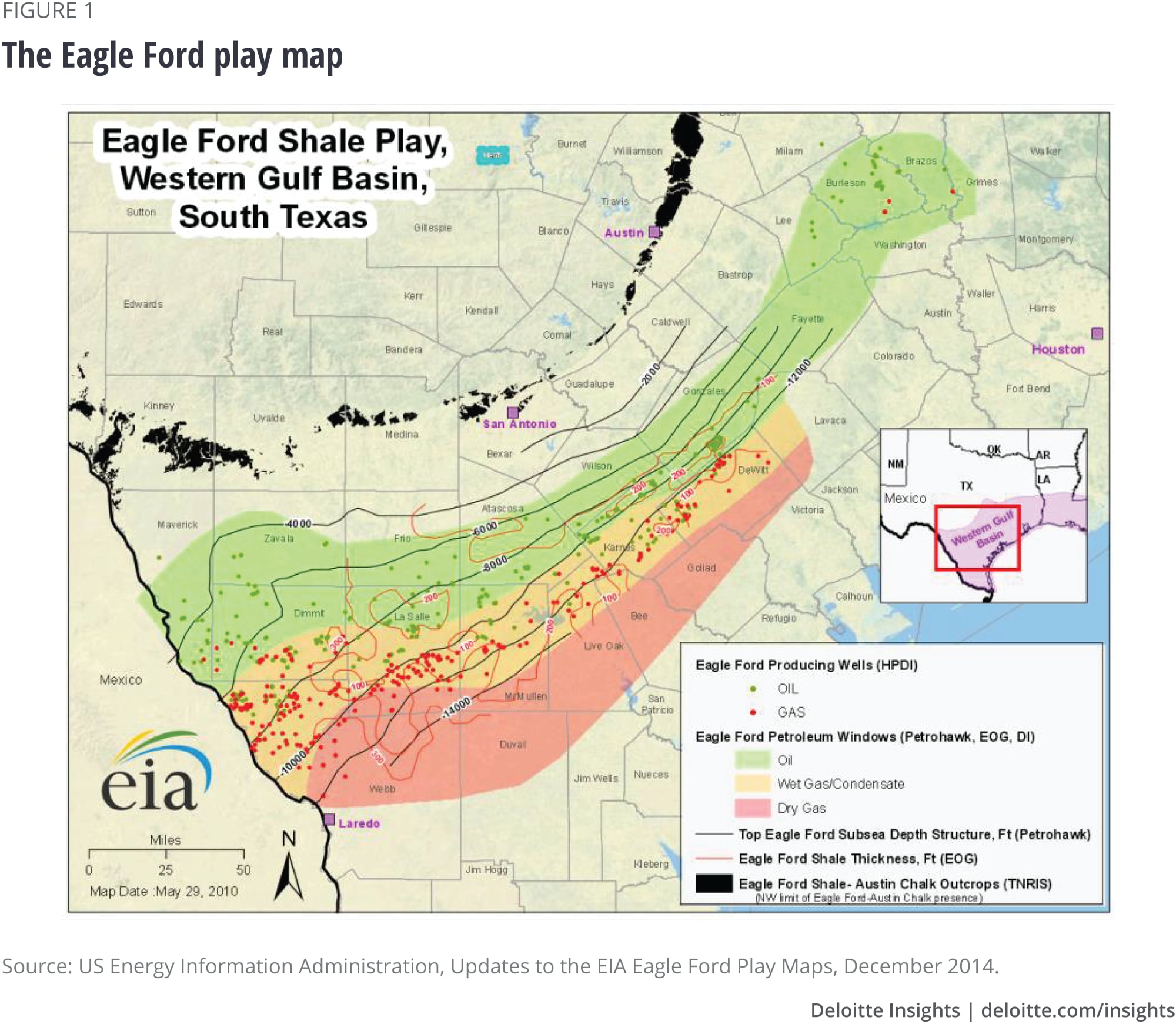
Eagle Ford: Several wins, many losses
The discovery of the Hawkville field in South Texas by Petrohawk Energy led to the first commercial production from the Eagle Ford shale in 2008.5 In just 10 months, the company assembled approximately 160,000 acres, and its first horizontal well in the basin produced 7.6 million cubic feet (MMCF) of natural gas and 250 barrels of liquids per day.6 The successful results and a wide range in the basin’s depth from 4,000 feet to 14,000 feet, along with excellent petrophysical properties, suggested that the basin had the right ingredients for a promising shale reservoir.7

In just a few years, Eagle Ford became the fastest-growing shale basin, surpassing even the Permian by producing close to 3 MMBoed in 2014.8 More than 50 percent of Eagle Ford’s cumulative production came from three counties: Karnes, DeWitt, and La Salle (see Figure 2).9 The basin attracted all types of operators due to its highly balanced oil-to-gas production mix of about 55:45.10 With 50,000 full-time job additions and contributions of over US$25 billion to the South Texas economy in 2013, David Porter, the then Railroad Commissioner of Texas said, “The Eagle Ford Shale has the potential to be the single most significant economic development in our state’s history.”11
However, with the sharp fall in oil prices, things changed. The drop in the basin’s rig count, from 218 in June 2014 to below 100 by July 2015, resulted in a precipitous fall in the addition of new producing wells in the Eagle Ford.12 By August 2017, the basin’s production fell to about 2 MMBoed and it still remains 20 percent below its peak.13
Considering the basin’s prolific resource base, how can Eagle Ford operators make a strong comeback and sustain their economics irrespective of the price cycles they are in? What can operators learn from their and peers’ underperformance (in terms of well productivity)? To what extent has their performance been affected by their beliefs (i.e., about location or formation quality)?
Formation quality matters, but . . .
Typically, a good starting point in understanding the basin is to map high-quality drilling locations that have a higher production potential. To identify these locations, or Tier 1 zones, an understanding of the geology, or the formation quality of rocks, is essential. In the Eagle Ford basin, our geospatial analysis on the formation quality score (refer to Deciphering the performance puzzle in shales) of each drilled well in the basin reveals three Tier 1 zones (refer to the methodology for more details), with the rest of the acreage termed as Tier 2/3 zone:
- First, northwest of the play, covering Dimmit, Webb, and La Salle counties
- Second, the central section, covering McMullen, Atascosa, and Live Oak counties
- Third, on the northeastern side, covering DeWitt, Karnes, and Gonzales counties
Certainly, every operator would like to own and drill in these high-quality zones. But does owning high-quality zones guarantee productivity for everyone? As our research suggests, it is incorrect to assume that wells outside these zones are always less productive than the rest. In fact, only 40 percent of the drilled wells in the Tier 1 zones had an initial 180-day productivity of more than 1,000 boed per 10,000 feet perforated interval.14 On the other hand, close to 45 percent of the wells drilled outside the Tier 1 zones had a well productivity of more than 1,000 boed (figure 3), suggesting that formation quality alone cannot guarantee superior well performance.15

The same is also evident from the fact that well productivity differs significantly both across the Tier 1 zones and within a zone. For example, average well productivity in the third Tier 1 zone is twice (about 1,700 boed) that of those in the first two Tier 1 zones.16 Similarly, within the third Tier 1 zone, more than 20 percent of wells have a productivity of below 1,000 boed.17 Although well productivity is slightly better in thicker formations (the Lower Eagle Ford), these formations also have both productive and less-productive wells.
Rather than undermining the importance of source rocks and faulting the nascent learning curve of operators, our analysis highlights a huge opportunity for course correction in the Eagle Ford—especially after learning that performance can be delivered across the zones, even from the nontrending counties/rocks. So, what really explains the underperformance of wells, both in good and not-so-good formations, and what is the size of the opportunity if underperformance is addressed? What propels results across formation types?
. . . so does completion design
Owning and drilling in top-quality shale acreage is advantageous only if wells are optimally engineered & completed (E&C). Getting the E&C part right in shales, however, isn’t easy, as shale operators have only 10–15 years of experience in completing a shale well, as against operators with decades of completion experience in conventionals. But one thing that hampers their learning curve is the notion that an optimum E&C design is one with longer laterals, more proppants, more fluids, etc. Explained the other way around, popular wisdom implies that simpler, less-intense E&C designs leads to underperformance of a well.
Our analysis of the E&C designs of all underperforming wells in both tiers (Tier 1 and the rest) and landing zones (Eagle Ford Upper and Eagle Ford Lower), however, challenge this notion. In fact, underperforming wells have both simple and intense designs, reflected in the wide range of their completion parameters (see figure 4). There are more than 1,000 underperforming wells with perforated interval of more than 7,500 feet in both the tiers and landing zones.18 Similarly, there are about 3,000 underperforming wells with proppant loading of less than 1,000 lbs/feet.19 In fact, there is notable design divergence in nonperforming wells from the same operators, reflecting the challenges faced by many in the well delivery process.
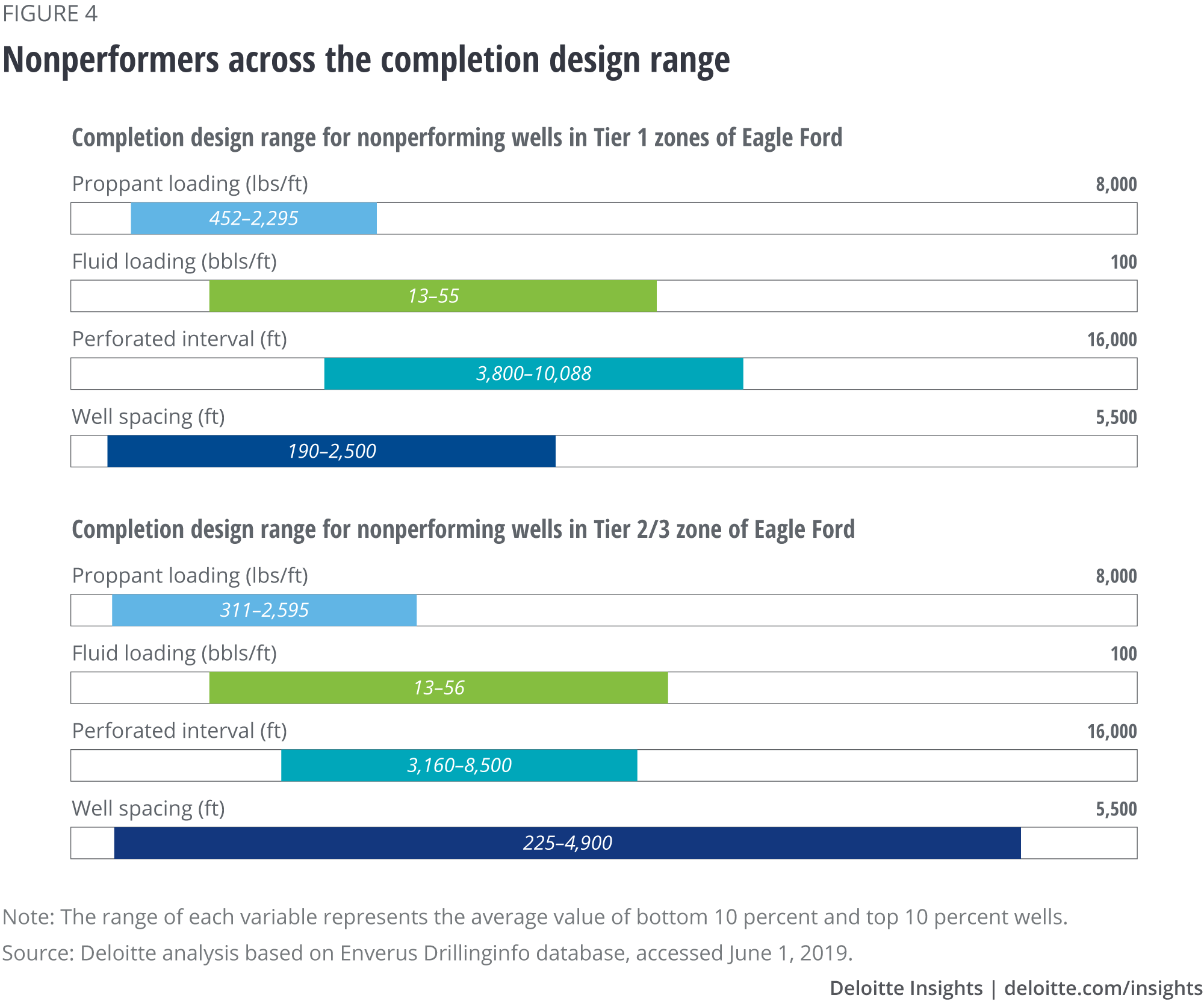
Apart from the over- or under-engineering of wells, an imbalance among many E&C variables is another problem. For example, in DeWitt county, there are about 250 over-engineered underperforming wells where notable imbalance amongst E&C variables is quite apparent.20 The outcome: An operator with wide-ranging well performance in the same county/formation, resulting in higher cost, reduced efficacy of well spacing, and less productive and suboptimal portfolio of wells overall.
While it may be difficult to find a single E&C design that fits all shale wells, are there some completion variables that explain productivity better? Could there be an ideal design “range” for each variable in a formation?
A three-step approach for operating optimally in the Eagle Ford
Optimizing completion designs for horizontal shale wells is a highly complex and technical subject, and the efficacy of these designs is largely dependent on the availability of data at the minutest possible levels and the cognitive basin knowledge of asset managers. Instead, consider a three-step approach that combines statistical processes and interpretations to complement technical design models specifically built for operators (see figure 5).
- Step 1: Identify significance of each completion variable (random forest)
- Step 2: Discover ideal design combinations and ranges (cluster analysis)
- Step 3: Model the significance and ranges into well type curves (well curves)
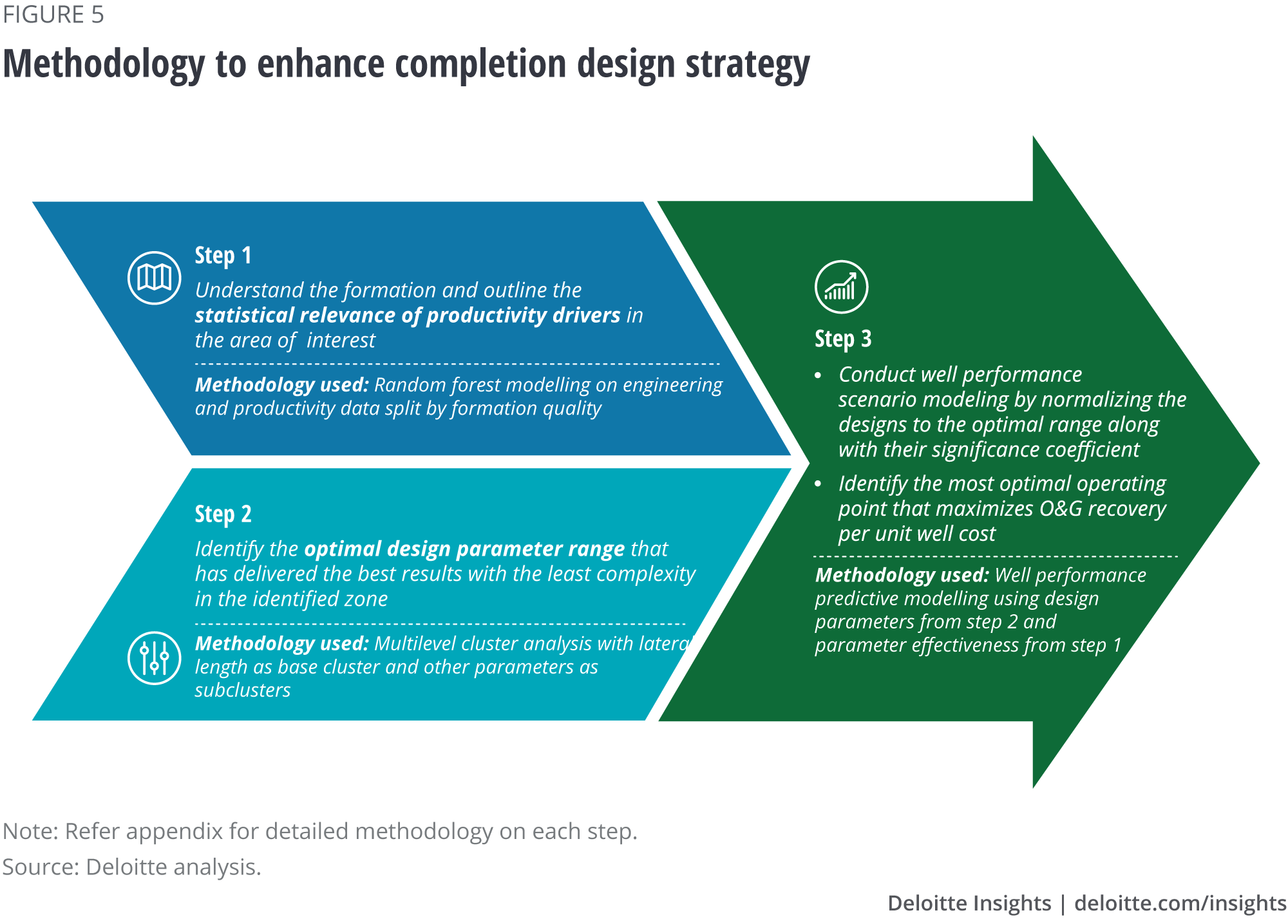
Step 1: Understand the significance of each completion variable
Indisputably, shale operators have registered tremendous gains in production due to enhanced and larger completion designs in the Eagle Ford. The broader “positive” relationship between completion design and well productivity is accepted by operators, but which completion variables better explain productivity is still an area of debate. It’s not that Eagle Ford operators aren’t tweaking their designs; it’s just that these tweaks are largely targeted at making designs more intense (e.g., more proppants and fluids).
Among several completion variables that are consistently reported by operators, five generally stand out—perforated interval, proppant quantity, fluid loading, proppant type, and treatment type (see figure 6). The random forest technique, a popular decision-making and ensemble method to build predictive models, statistically highlights the significance of each of the five variables in explaining well productivity across the Eagle Ford. Remarkably, the first three variables—perforated interval, proppant quantity, and fluid loading—influence productivity by more than 85 percent, but with significant divergence across the tiers/zones.21
Proppant loading per perforated interval seems to be the primary driver of productivity (significance of about 33 percent) across the Eagle Ford, in both Upper and Lower zones.22 Equally important are fluid volumes (significance of about 30 percent) as they carry the proppant and help to create the fracture.23 However, both proppant (sand, resin, ceramic) and treatment types (slickwater, crosslink, hybrid, linear gel) seem to have low significance (about 11–14 percent in aggregate) in explaining the productivity in the basin.24 What does this mean for operators in the basin? How do these numbers corroborate with the basin’s closest peer, the Permian?
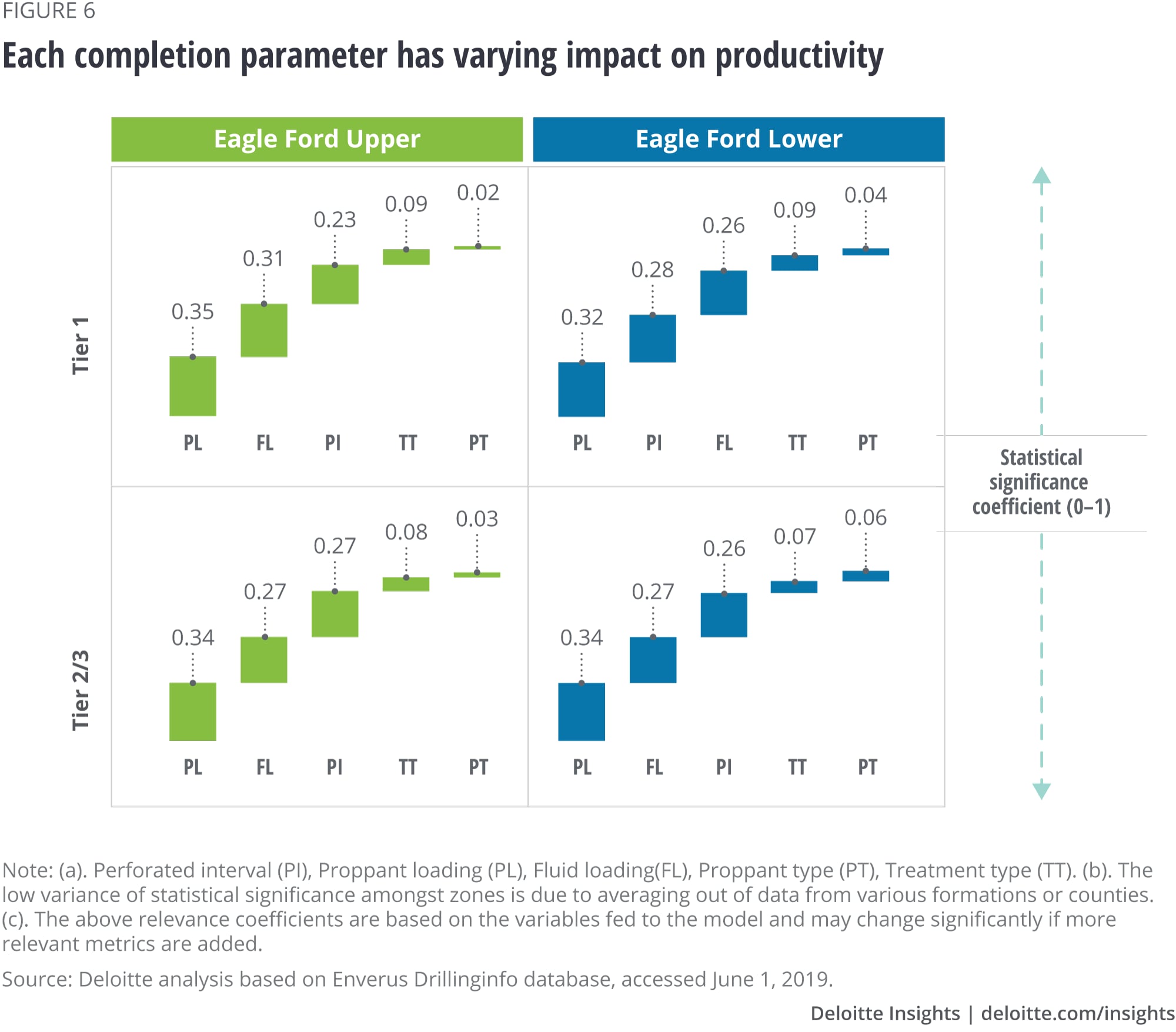
Like in the Permian, there is a mature congruence between the statistical significance of completion variables and the action of companies in the Eagle Ford, at least on proppant types. In both the Eagle Ford and the Permian, for example, the significance of proppant type is between 2–6 percent and only 9–10 percent of wells spud since 2016 used expensive proppants (ceramic and resins).25
Treatment types, on the other hand, are still in the early phase of experimentation, even in the Eagle Ford. Although our results highlight its low relation in explaining productivity, operators across the basins continue to experiment with new stimulation treatments: hybrid, linear gel, or cross-linked gel. About 50 percent of wells drilled in the past three years used non-slickwater as a fluid in the Eagle Ford.26 But some private operators are increasingly gravitating toward 100 percent slickwater (with little or no polymer), which, although constrained by local water availability, is a cost-effective fluid.27
Step 2: Identify optimal design ranges
After identifying the significance of each completion variable, the next step involves narrowing down the wide range of completion designs or identifying an ideal operating range for each variable. As both high- and low-productive wells are on both ends of the design spectrum, an ideal design would be the one that delivers the highest productivity with least design complexity/intensity (and thus cost). Our multilayered cluster modeling approach, with perforated interval (the biggest cost component) as the primary cluster and other parameters as subclusters, reveals ideal operating ranges of high-productive wells in each tier/zone (see figure 7).
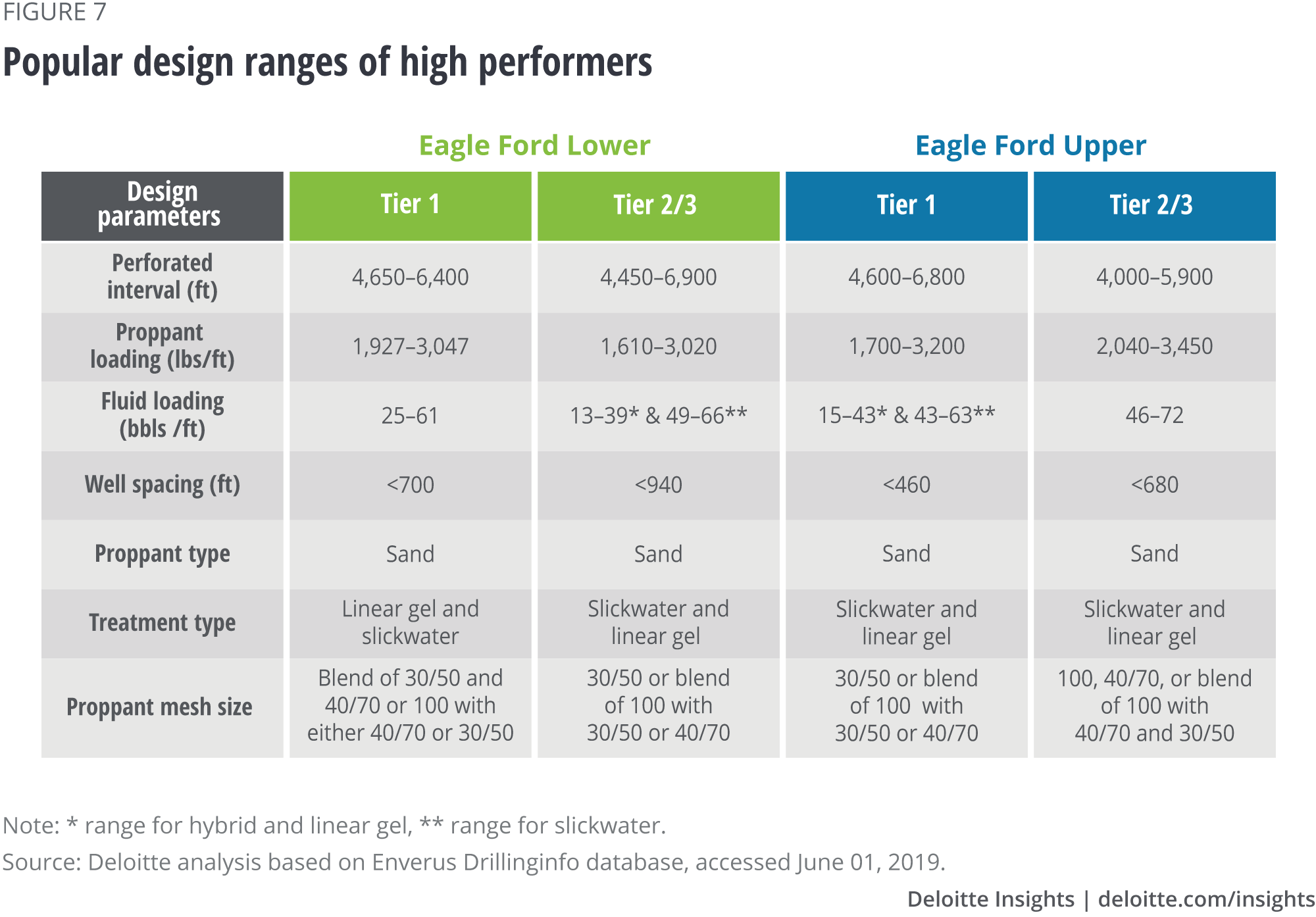
Since 2016, the largest cluster of high-productive wells has been within a perforated interval of 4,600–6,800 feet in Tier 1 zones, despite many companies holding continuous acreages in the area. In the Lower Eagle Ford (Tier 1), these high-productive wells saw proppant quantities in the range of 1,900–3,000 lbs/feet with slickwater fluid pumped at 25–61 barrels (bbls)/feet. In the Tier 2/3 zones, however, the range is much wider between the Upper and Lower Eagle Ford.28 In the Upper Eagle Ford, for example, proppant and fluid intensity is high and operators use a finer proppant mesh size of 100.29 Such a high variance confirms both challenges and opportunities in ascertaining a right completion design—high productivity at the right intensity and cost—for operators.
(Note: These ranges can, and should, be narrowed down further at a county and specific landing zone by feeding proprietary completion data and triangulating it with in-depth rock and formation understanding of operators/vendors.)
Benchmarking designs of operators
Only 40 percent of completed and producing wells in the Eagle Ford (green and light green shades) are within or close to the ideal completion ranges (see figure 8). Most of these wells are in Karnes and DeWitt, where strong subsurface characteristics are complementing simpler completion designs. Among the company groups, the top five operators and large independents have a slightly higher proportion of wells in ideal ranges compared to their smaller peers—nevertheless, the scope for improvement is significant for all.
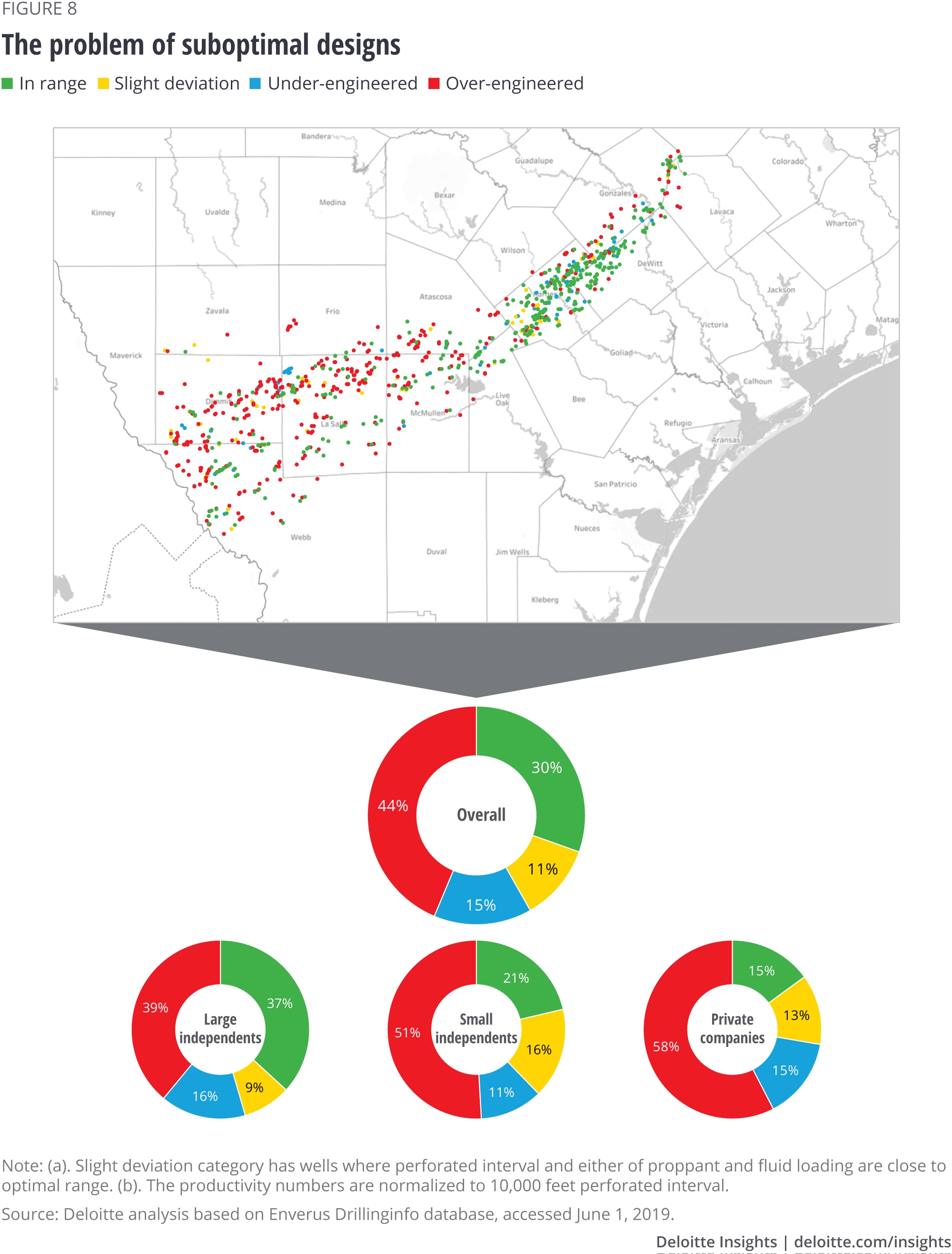
Approximately 45 percent of producing wells in the basin had intense/complex designs and longer perforated interval (see doughnut in figure 8 with “over-engineered” marked in red), possibly to offset the basin’s relatively weaker reservoir and rock characteristics in the west (refer to Deciphering the performance puzzle in shales). Although counties in west Texas—Maverick, Dimmit, Webb, and La Salle—have thick target intervals, their less attractive rock quality has led to lower and inconsistent well performance. The result: Higher completion cost and lower-than-expected results on the productivity front.
Speaking of the rest, a few operators seems to have mastered a unique combination of completion designs. For example, one of the leading independent E&P is going for much shorter wells, perforated interval of 2,000–4,000 feet, but with much higher proppant (averaging 2,800 lbs per 10,000 feet length) and fluid intensity (57 bbls per 10,000 feet perforated interval).30 The company is saving on its biggest cost component, lateral length, without impacting its productivity (in fact, the company is maximizing its contact with the most reservoir rock). But, there are also a few operators for whom their overly simplistic designs are not yielding the desired productivity results.
Step 3: Identify the right balance between production and cost
After the significance and ideal operating ranges of each completion variable are identified, the last step is to forecast a well’s performance by tweaking its completion design and comparing with its actual results. The gap or opportunity, however, isn’t just about highlighting the potential of producing higher volumes. It is actually about finding the right balance between production and cost—or rather, maximizing well recovery (estimated ultimate recovery, or EUR) per unit of well cost (drilling and completion cost).
Productivity and economic models leveraging the optimal ranges and statistical relevance of completion variables for 1,400 over-engineered wells revealed an opportunity to enhance EUR per unit of well cost by 19 percent (see figure 9).31 In other words, operators in Eagle Ford could have saved approximately 19 percent of their drilling and completion capex and realized a similar level of production from these wells. These savings could ideally be achieved by fine-tuning the currently “over-engineered” designs, where cost savings resulting from simpler designs more than offsets the fall in production. Some players with massive surface infrastructure might still do well with over-engineered wells as it brings down other cost elements but for the rest, optimizing this equation at a well level might work better.

Generally speaking, under-engineered wells should also present an opportunity to enhance recovery per unit of well cost—quite apparent in the Permian basin (refer The Permian basin playbook: Optimizing design experimentation). However, intensifying designs for these wells in the Eagle Ford doesn’t seem to improve capital efficiency—in fact, EUR/well cost fell by 12–17 percent.32 This also seems to affirm the point highlighted earlier that responsiveness of many mature Eagle Ford formations toward completion designs is relatively weak and hence leads to suboptimal designs on the economic front—modeling 500 under-engineered wells for superior designs led to productivity gains of 2–11 percent, but with a 25 percent increase in cost.33 This implies that making a lot of tweaks to under-engineered wells in the basin may not make economic sense every time.
To sum up, the relatively unfavorable response of rocks in the Eagle Ford basin requires a careful mapping of formation type with the best operating completion designs. Although performance enhancements in many areas are a testimony of improvements done by many operators using their technical know-how, our analysis suggests scope to further augment the learnings with an analytical understanding of the basin. The task of finding such best operating points can be quite challenging and critical in Eagle Ford, as the ranges are narrow and even a slight deviation may lead to notable economic loss.
Amid changes, opportunities remain
Subsurface characteristics of the Eagle Ford basin and, most importantly, an ongoing trend among operators across the basins for complex yet ineffective designs, validate falling drilling activity in the Eagle Ford and affirm investors’ skepticism in investing in shale companies. Certainly, this young resource merits a learning concession. However, in today’s age of resource abundance and sustained volatility in oil prices, companies that have a faster and efficient learning curve are likely to emerge as winners. Certain considerations that could enable this learning include:
- Veer from intensity to combinations. Add more meaning to the trend of enhancing the E&C design intensity by identifying the “right” design combinations customized to each rock.
- Refresh the portfolio strategy rulebook. Break away from a mindset of optimizing portfolios based on just the quality of formation and add new elements, such as experience in the field, response to various designs, and infrastructure availability.
- Avoid herd instincts. Appreciate the value learning from peers while recognizing shale’s erratic behavior. Although a strategy (e.g., intense Gen X completions) might look appealing, it may not make economic sense for all and could hurt project returns.
- Replace selectivity with entirety. Move away from selective reporting of parameters and present a comprehensive picture and report out learning progressions to build investor confidence.
Appendix
Key assumptions and considerations
- The analysis presented here is an analytical perspective to shale development and hence cannot be a replacement to sophisticated technical models.
- The formation quality zones are classified using available geological data points (gamma ray, neutron porosity, formation thickness, deep resistivity, bulk density) and these should not be directly compared with other technical formation quality maps.
- The statistical relevance of various completion variables is based on the number of variables fed to the model. These numbers would change if more data or more variables are used to build models.
- The defined optimal operating points are directional ranges aimed to highlight the divergence by each zone. These could change notably once analyzed at formation or county level and hence should not be directly leveraged for technical analysis.
- The optimal operating point reflects designs with moderate intensity and high productivity. Hence, it should not be assumed that designs which are more intense are always less productive.
The economic well models are based on recent cost trends in each sub-basin and actual numbers may vary based on company-specific cost efficiencies.
Methodology to define boundary of zones by formation quality
At first, spatial mapping of all the wells in a basin was done using surface latitude and longitude data. Further, low-formation quality wells were filtered out using the formation quality index developed in the first article, Deciphering the performance puzzle in shales (wells with a formation score of less than 0.55 were filtered out in the Eagle Ford basin).
A geospatial mapping tool then allowed us to manually define the boundary of the zone that comprises most of the high-quality wells and generate the latitude-longitude readings of the newly created boundary (see figure 10). This newly created geographic zone comprising high-quality wells was termed as the Tier 1 formation, while the rest was defined as the Tier 2/3 zone. Lastly, graphical overlaying with existing formation quality maps by various operators was done to fine-tune the formation quality zone boundaries.
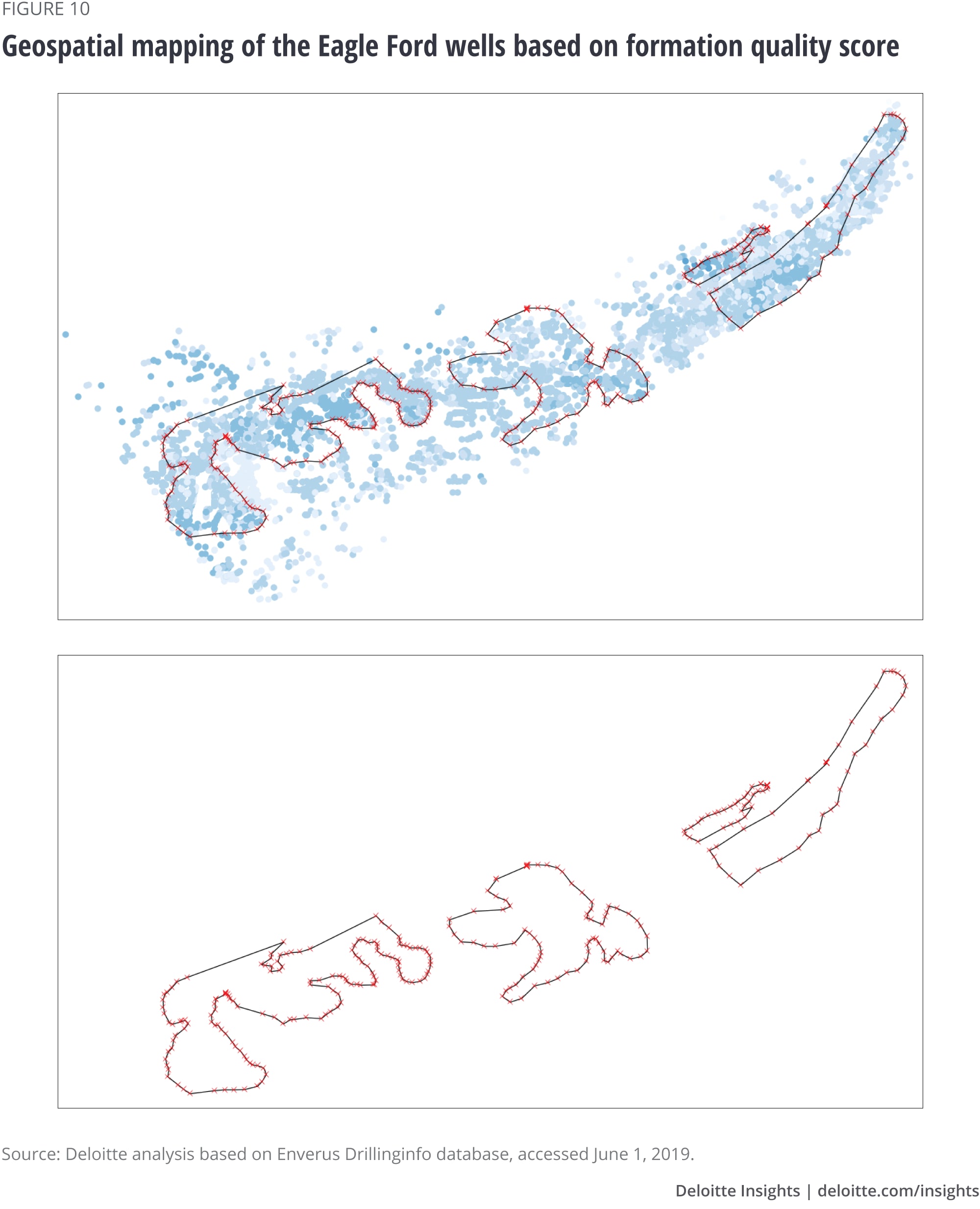
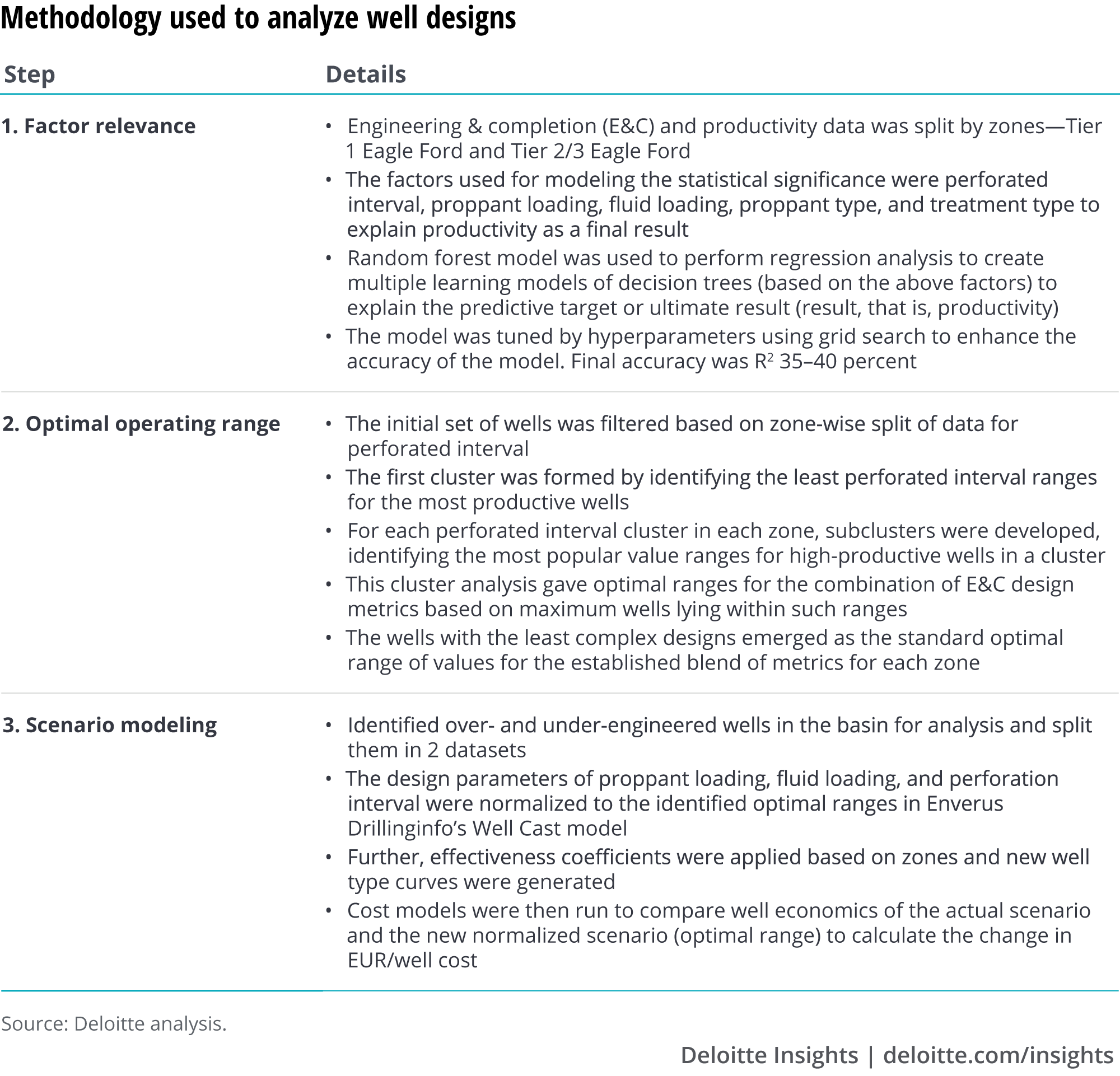
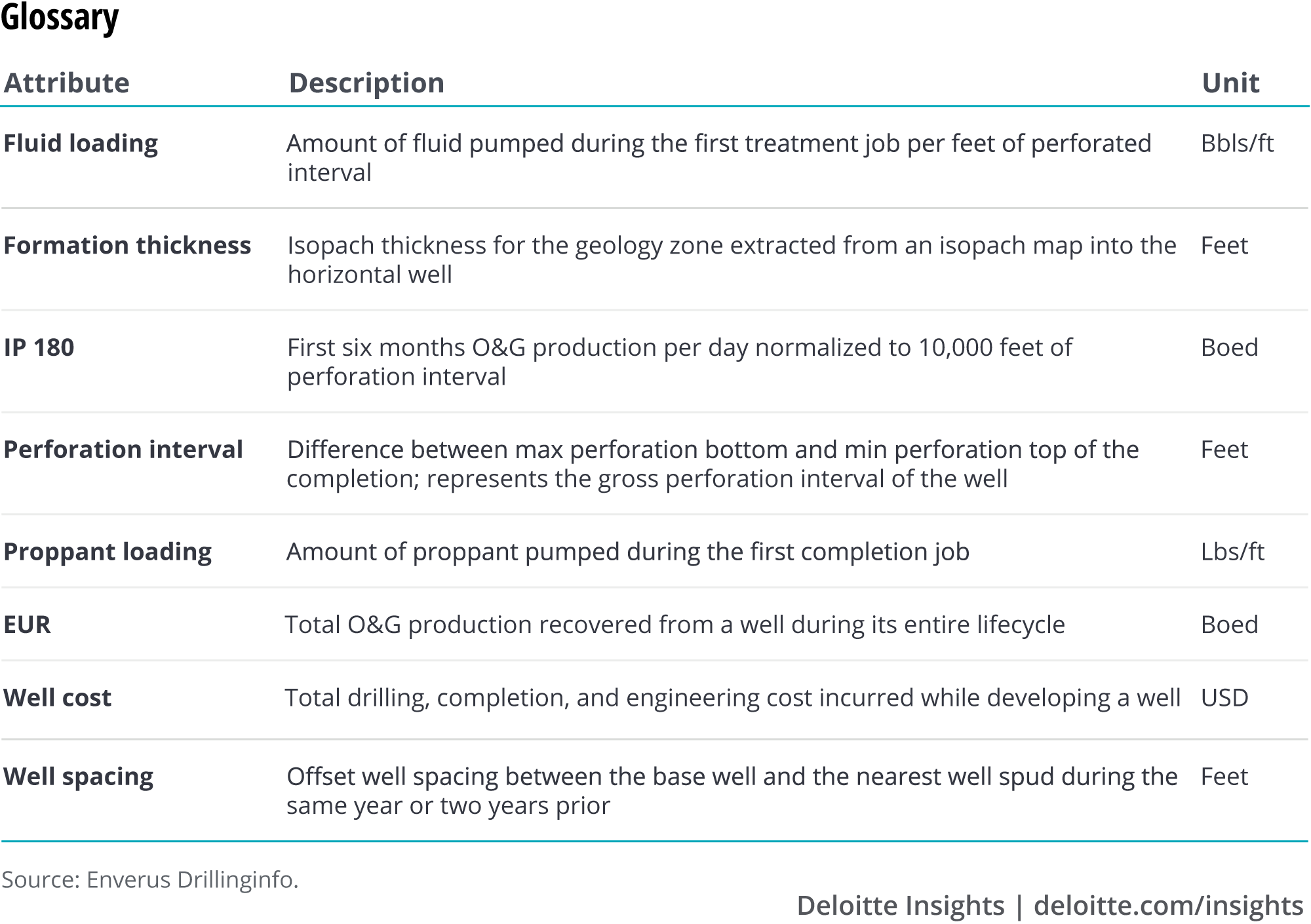
© 2021. See Terms of Use for more information.
More in Oil, Gas & Chemicals
-
How the shale revolution is reshaping the US oil and gas labor landscape Article6 years ago
-
Oil’s well?: Divergence and imbalance in the oil and gas ecosystem Article5 years ago
-
One Downstream Article5 years ago
-
Energy management: Paused by pandemic, but poised to prevail Article4 years ago
-
Refining & marketing: Eyeing new horizons Article5 years ago












